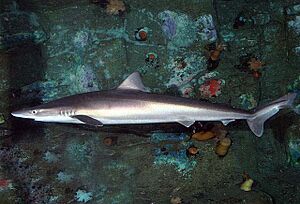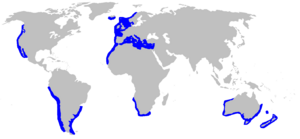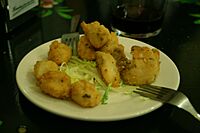School shark facts for kids
Quick facts for kids School shark |
|
|---|---|
 |
|
| Conservation status | |
| Scientific classification | |
| Genus: |
Galeorhinus
|
| Species: |
galeus
|
 |
|
| Synonyms | |
|
List
|
|
The school shark (Galeorhinus galeus) is a type of houndshark. It's the only shark in its group, Galeorhinus. People also call it the tope shark or soupfin shark. This shark lives in cool waters all over the world. It can be found deep in the ocean, up to 800 m (2,600 ft) down. School sharks can grow to almost 2 m (6 ft 7 in) long. They hunt for food both in the open water and near the ocean floor.
School sharks give birth to live young, which is called ovoviviparous reproduction. These sharks are caught by fishers for their meat, fins, and liver. Their liver is special because it has a lot of vitamin A. Sadly, the IUCN (International Union for Conservation of Nature) says the school shark is critically endangered. This means it's at a very high risk of disappearing from the wild.
Contents
What Does a School Shark Look Like?
The school shark is a slender shark with a long snout. Its mouth is shaped like a crescent moon. The teeth in both its upper and lower jaws are similar. They are small, flat, and triangular. Each tooth points backward and has a jagged edge with a small notch. School sharks also have tiny breathing holes called spiracles.
The first top fin (dorsal fin) is triangular. It sits right behind the side fins (pectoral fins). The second top fin is about the same size as the bottom fin (anal fin). It is placed directly above it. The tail fin has a notch at the very end. The end part of the tail is as long as the rest of the fin.
School sharks are dark bluish-grey on their backs. Their bellies are white. Young school sharks have black marks on their fins. Adult males are usually 135 to 175 cm (53 to 69 in) long. Adult females are bigger, ranging from 150 to 195 cm (59 to 77 in).
Where Do School Sharks Live?
School sharks live in many places around the world. They prefer cool, temperate waters. You can find them mostly near the ocean floor, sometimes as deep as 800 m (2,600 ft).
They live in the Northeast Atlantic Ocean and the Mediterranean Sea. They are not very common there. They are also found in the Southwest Atlantic, from Patagonia to southern Brazil. You can see them off the coasts of Namibia and South Africa. In the Northeast Pacific, they live from British Columbia down to Baja California. They are also found in the Southeast Pacific, off Chile and Peru. Finally, school sharks swim around the southern coasts of Australia, including Tasmania, and New Zealand.
School Shark Behaviour
School sharks are known to travel long distances. They are a migratory species. Sharks tagged in the United Kingdom have been found far away. Some were found in the Azores, others in the Canary Islands, and even Iceland. School sharks tagged in Australia have traveled 1,200 km (750 mi) along the coast. Some even swam all the way to New Zealand.
What Do School Sharks Eat?
School sharks mainly eat fish. Scientists have looked at what's inside their stomachs. Sharks caught off California ate whatever fish were easiest to find. Their diet mostly included sardines, midshipmen, flatfish, rockfish, and squid. They hunt both in open water and near the seabed. Sardines and squid live in open water (pelagic). The other fish they eat live near the bottom (benthic).
School Shark Reproduction and Life Cycle
School sharks are ovoviviparous. This means their eggs are fertilized inside the mother. The baby sharks grow inside the mother's uterus. They get their food from a large yolk sac.
Male school sharks become adults when they are about 135 cm (53 in) long. Females mature at about 150 cm (59 in). The babies grow inside the mother for about one year. The number of pups (baby sharks) depends on the mother's size. On average, a mother shark has between 28 and 38 pups. Sometimes, pups in the same litter can have different fathers. This might be because females can store sperm for a long time after mating.
Female sharks go to special "pupping" areas to give birth. These are usually calm bays and estuaries. The young sharks stay in these safe nursery areas. The adult sharks then move to deeper waters.
How People Use School Sharks
School sharks have been an important resource for the Māori people in New Zealand. They call the shark kapetā. Māori groups would travel to special events in the Rangaunu Harbour. There, they could fish for kapetā for two days. The meat was eaten fresh or preserved. The oil from the shark's liver was mixed with plants and red ochre. This mixture was used to make cosmetics.
The meat of the school shark is eaten in Andalusian cuisine in Spain. It is often called cazón. A traditional dish is cazón en adobo, which is marinated shark. In the Canary Islands, it's called tollos. In Mexican cuisine, the word cazón refers to other shark species. They are prepared in a similar way. In the United Kingdom, school shark meat is sometimes used in "fish and chips". It can be a substitute for cod or haddock.
Before 1937, school sharks were caught in California for their meat. Their fins were dried and sold in Asia. Around 1937, tests showed that their liver had more vitamin A than any other fish. This discovery led to a much larger fishery. People caught many sharks because of the high price for their liver and meat. During World War II, it was the main source of vitamin A in the United States. However, too many sharks were caught. Their numbers dropped, and fewer fish were available. Later, other fish oils replaced school shark oil.
Today, the school shark is very important in the southern Australian fishing industry. It is caught throughout its range and is heavily fished.
Protecting School Sharks
The IUCN lists the school shark as critically endangered. This means it is at a very high risk of extinction. Even though it lives in many places, it is threatened by overexploitation. This means too many sharks are being caught. People target them for their liver oil, meat, and fins.
School sharks are mostly caught using gillnets and longline fishing. They are also caught by trawling, but less often. Young sharks are sometimes caught near the shore. Some nursery areas are getting filled with silt. Their homes can also be damaged. Deep-sea cables and the magnetic fields they create might also affect shark migration routes.
In 2010, Greenpeace International added the school shark to its seafood red list. This list names species that are at risk. In June 2018, the New Zealand Department of Conservation said the school shark was "Not Threatened" in New Zealand. However, they added that it is "Conservation Dependent" and "Threatened Overseas." This means it needs help to survive and is in danger in other parts of the world.
Images for kids







